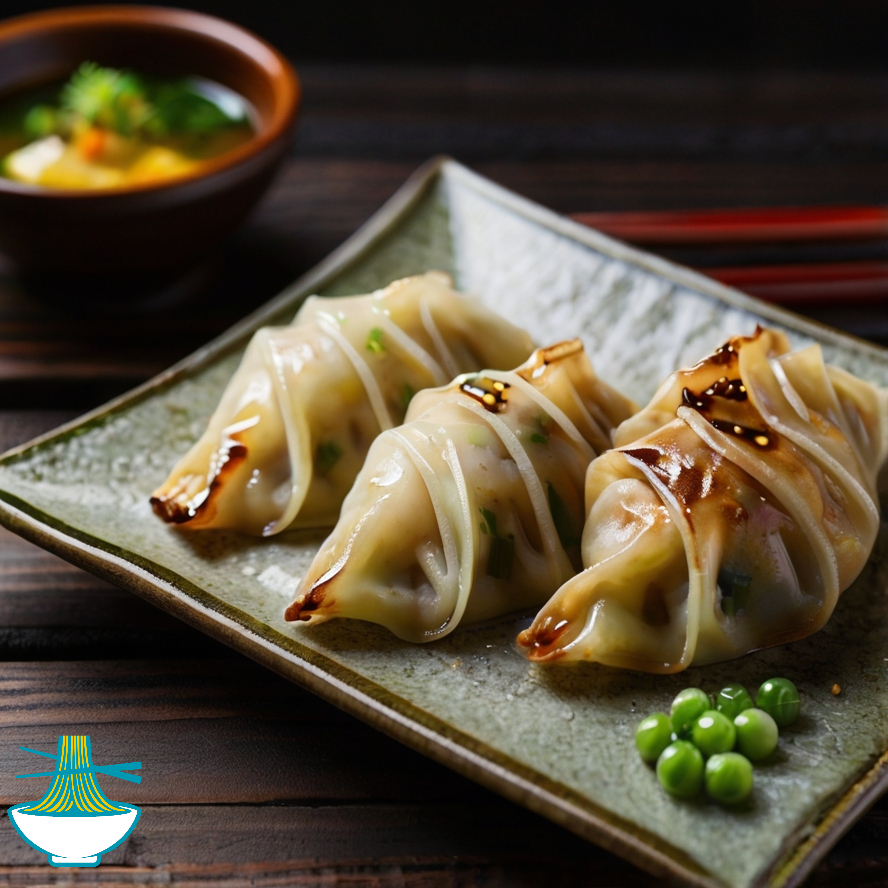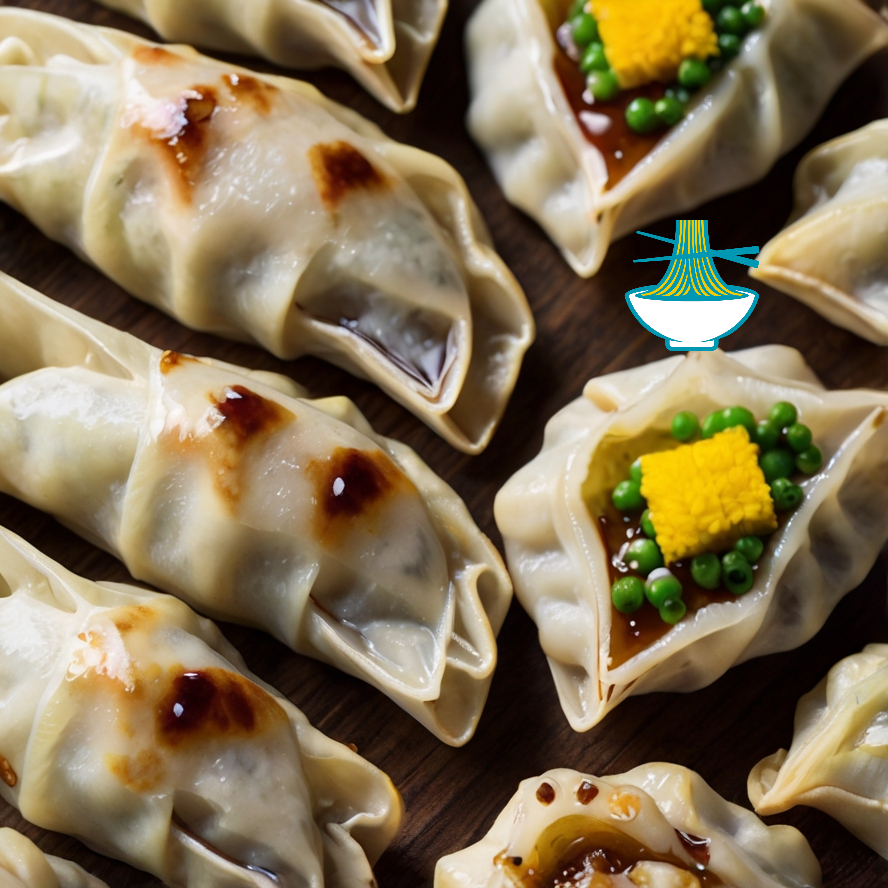Dive into the delectable world of Japanese cuisine with our guide to Gyoza, the iconic dumplings that tantalize taste buds worldwide. Originating from Japan, these handcrafted delights feature thin dough envelopes stuffed with a savory blend of minced meat, vegetables, and aromatic seasonings, then expertly pan-fried or steamed to perfection. Learn about the history, cultural significance, and regional variations of Gyoza, and discover tips for making and enjoying these irresistible bites at home. Whether enjoyed as appetizers, snacks, or part of a satisfying meal, Japanese Gyoza promises a culinary adventure that delights and satisfies.
Ingredients:
For the filling:
- 300g ground pork (can also use chicken or a combination of pork and shrimp)
- 2 cups finely shredded cabbage
- 2-3 green onions, finely chopped
- 2 cloves garlic, minced
- 1 tablespoon ginger, grated
- 1 tablespoon soy sauce
- 1 tablespoon sesame oil
- 1 teaspoon sugar
- Salt and pepper to taste
For the wrappers:
- Gyoza wrappers (available at Asian grocery stores)
- Water (for sealing)
For cooking:
- Vegetable oil
For the dipping sauce:
- 3 tablespoons soy sauce
- 2 tablespoons rice vinegar
- 1 teaspoon sesame oil
- 1 teaspoon chili oil (optional)
- Finely chopped green onions (optional)
Instructions:
1- Prepare the filling: In a large mixing bowl, combine ground pork, shredded cabbage, green onions, garlic, ginger, soy sauce, sesame oil, sugar, salt, and pepper. Mix well until everything is evenly combined.
2- Assemble the gyoza: Take a gyoza wrapper and place about 1 tablespoon of filling in the center. Dip your finger in water and moisten the edges of the wrapper. Fold the wrapper over the filling and pinch the edges together to seal. You can pleat the edges if desired for a decorative touch. Repeat until all the filling is used.
3- Cook the gyoza: Heat a tablespoon of vegetable oil in a non-stick skillet over medium heat. Once hot, arrange the gyoza in the skillet, making sure they're not touching each other. Cook for 2-3 minutes or until the bottoms are golden brown.
4- Steam the gyoza: After the bottoms are browned, add about 1/4 cup of water to the skillet and immediately cover with a lid. Steam the gyoza for 5-6 minutes or until the wrappers are translucent and the filling is cooked through.
5- Make the dipping sauce: While the gyoza are cooking, prepare the dipping sauce by combining soy sauce, rice vinegar, sesame oil, and chili oil in a small bowl. Stir well to combine.
6- Serve: Once the gyoza are cooked, remove them from the skillet and serve hot with the dipping sauce on the side. Garnish with finely chopped green onions if desired. Enjoy your homemade Japanese Gyoza!
This recipe makes approximately 30 gyoza, but you can adjust the quantities based on your preference. Feel free to customize the filling with your favorite ingredients!
Nutritional Values :
Here’s the breakdown of Nutritional Values and Benefits for the ingredients listed:
Filling Ingredients:
Ground Pork (300g):
- Calories: 720 kcal
- Fat: 60g
- Carbohydrates: 0g
- Protein: 54g
Benefits: High in protein and fat; provides essential amino acids and vitamins.
Finely Shredded Cabbage (2 cups, ~150g):
- Calories: 30 kcal
- Fat: 0g
- Carbohydrates: 7g
- Protein: 1g
Benefits: Low in calories; provides fiber, vitamins C and K.
Green Onions (2-3, ~50g):
- Calories: 15 kcal
- Fat: 0g
- Carbohydrates: 4g
- Protein: 1g
Benefits: Adds flavor and provides vitamins A, C, and K, along with antioxidants.
Garlic (2 cloves):
- Calories: 10 kcal
- Fat: 0g
- Carbohydrates: 2g
- Protein: 0g
Benefits: Contains compounds with potential health benefits, such as allicin, which may have antimicrobial properties.
Ginger (1 tablespoon, ~10g):
- Calories: 8 kcal
- Fat: 0g
- Carbohydrates: 2g
- Protein: 0g
Benefits: Provides a spicy kick and may aid in digestion and reduce nausea.
Soy Sauce (1 tablespoon):
- Calories: 10 kcal
- Fat: 0g
- Carbohydrates: 1g
- Protein: 1g
Benefits: Adds umami flavor; contains antioxidants.
Sesame Oil (1 tablespoon):
- Calories: 120 kcal
- Fat: 14g
- Carbohydrates: 0g
- Protein: 0g
Benefits: Rich in healthy fats; provides a distinctive flavor and contains antioxidants.
Sugar (1 teaspoon):
- Calories: 16 kcal
- Fat: 0g
- Carbohydrates: 4g
- Protein: 0g
Benefits: Adds sweetness and balances flavors.
Salt and Pepper (to taste):
- Calories: 0 kcal
- Fat: 0g
- Carbohydrates: 0g
- Protein: 0g
Benefits: Enhances flavor; salt helps in retaining moisture in the filling.
Wrappers and Cooking:
Gyoza Wrappers (per wrapper, ~20 wrappers):
- Calories: 30 kcal per wrapper
- Fat: 1g
- Carbohydrates: 5g
- Protein: 1g
Benefits: Provides the structure for the dumplings; contributes carbohydrates and some protein.
Water (for sealing):
- Calories: 0 kcal
- Fat: 0g
- Carbohydrates: 0g
- Protein: 0g
Benefits: Used for sealing the wrappers.
Vegetable Oil (for cooking, 1 tablespoon):
- Calories: 120 kcal
- Fat: 14g
- Carbohydrates: 0g
- Protein: 0g
Benefits: Used for frying; adds calories and fats to the dish.
Dipping Sauce:
Soy Sauce (3 tablespoons):
- Calories: 30 kcal
- Fat: 0g
- Carbohydrates: 3g
- Protein: 3g
Benefits: Adds flavor; contains antioxidants.
Rice Vinegar (2 tablespoons):
- Calories: 10 kcal
- Fat: 0g
- Carbohydrates: 2g
- Protein: 0g
Benefits: Adds tanginess; may aid digestion.
Sesame Oil (1 teaspoon):
- Calories: 40 kcal
- Fat: 4.5g
- Carbohydrates: 0g
- Protein: 0g
Benefits: Adds flavor; contains healthy fats and antioxidants.
Chili Oil (1 teaspoon, optional):
- Calories: 40 kcal
- Fat: 4.5g
- Carbohydrates: 0g
- Protein: 0g
Benefits:Adds spiciness; may help boost metabolism.
Finely Chopped Green Onions (optional):
- Calories: 5 kcal
- Fat: 0g
- Carbohydrates: 1g
- Protein: 0g
Benefits: Adds flavor and provides vitamins and antioxidants.
Please note that these values are approximate and can vary based on factors such as brand, preparation methods, and specific ingredients used. Additionally, the nutritional values for the dipping sauce ingredients are not included here, as they depend on the specific quantities used and can vary based on personal preferences.


Comments